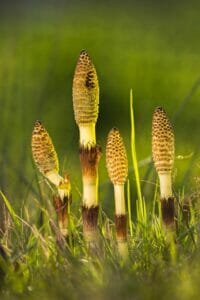The need for horsetail control
Somewhat surprisingly, horsetail can create some real issues by taking over garden borders, ruining patios and even pushing up through tarmac surfacing and cracks in concrete hardstanding. It’s extremely resistant to herbicides and if you try and dig it out by hand you could end up with a bigger problem than you started with. However, the real need for horsetail control arises from the harm it can do to horses and cattle, poisoning them when ingested.
Horsetail is an ancient plant and tricky adversary
Horsetail comes in two main varieties in the UK, eqisetum arvense and equisetum telmateia, or field horsetail and great horsetail to you and me. This fern-like plant sinks its rhizomes deep into the soil and it sends out spores in the spring from cone-like structures on pale brown stalks. Field horsetail will generally grow to around 30 centimetres tall, whereas great horsetail normally tops out at about a metre. As any gardener who has dealt with it will tell you, horsetail control is not an easy thing to accomplish and eradication may be impossible. Read on to find out more.
Why worry about controlling horsetail?
Although its name was coined by its appearance, ironically Horsetail is quite dangerous for horses and is listed in the RSPA document: Weeds and plants toxic to equines. Whilst thankfully the plant is unpleasant for them to graze on, if present in reasonable amounts in hay, there will be a significant impact on the feeding horses by impacting their ability to produce vitamin B1. Symptoms include muscle wastage, an unsteady gait, depression and constipation.
Horsetail identification

Great horsetail stems and strobilus
Horsetail and Mare’s tail are frequently confused, it is common that when carrying out a web search to see ‘Horsetail, also known as Mare’s tail…’ and some ‘expert’ websites list the two plants as the same thing. There are similarities but, unless you have a stream or bog at the end of your garden it is unlikely to be the latter, and if the plant flowers it is certainly not Horsetail. Mare’s tail is an aquatic or marginal plant that is native to the UK and rarely causes any problems, although it can spread to the point where it will choke small water courses.
Some of the distinctive characteristics of Horsetail can be seen in the pictures provided. The bud-like head pictured to the left is called the strobilus; it is dotted with sporangium, the enclosures where spores are created for reproduction. Although the plant also reproduces buy siding out underground rhizome.
Other notable characteristics include the horsetail stem with its distinctive nodes, and of course the the waxy leaves of the plant arranged in whorls that are fused into them.
By summer the plants will look quite full, standing at a height of approximately 2 feet. They have the appearance of mini fir tree-like plants.
Horsetail control methods
- Frequent and regular mowing of horsetail in lawns can control its growth quite successfully.
- Professional, targeted herbicide applications can be effective at controlling horsetail as part of an ongoing maintenance programme, though full eradication using this method is unlikely.
- Covering the affected area with a completely lightproof barrier can weaken the plant effectively, although this isn’t always a very practical solution.
- Digging out the rhizome by hand has often been attempted and is rarely successful. Gardening forums are littered with stories of this method actually making matters worse.
- PBA Solutions offer hybrid control programmes for horsetail that can include mechanical excavation and specialist root barrier installations, as well as herbicide treatments.
Horsetail facts
- We have two native forms in the UK, field horsetail and great horsetail (equisetum arvense and equisetum telmateia).
- One of the oldest plants on the planet – it has been around for at least 400 million years.
- Spreads by rhizome growth, cultivation and soil disturbance, spores.
- Tough to control and extremely hard to eradicate.
- It will quickly take over cleared land, making it a real annoyance for developers.
- Horsetail can wreck the appearance of patios and will push up through tarmac.
- Rhizomes (with tubers attached) can penetrate more than two metres down into the soil.
- Not many horsetail spores make it into fully developed plants but the life of a spore is amazing – once a spore lands, it deploys four tiny ‘legs’ which elevate if from the ground, helping carry the spores away to pastures new even on a gentle breeze.
- Horsetail fossils are regularly found in lumps of coal.
- Horsetail is poisonous to cattle, sheep and, as previously noted, horses.
Help with horsetail
PBA Solutions is an established company specialising in non-native and native (UK) invasive plant species. We’re here to help if you need horsetail weed control or to deal with other invasive plant species on your land. We work with property owners and management, estate agents, developers and public sector organisations in the remediation of infested land. Where it’s needed, we develop and provide Management Plans that enable effective control solutions, always looking to avoid expensive and environmentally damaging waste-to-landfill operations wherever possible.
Just call 0203 174 2187 or 01202 816134 to talk to one of our consultants.

